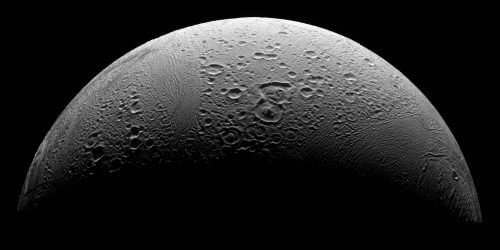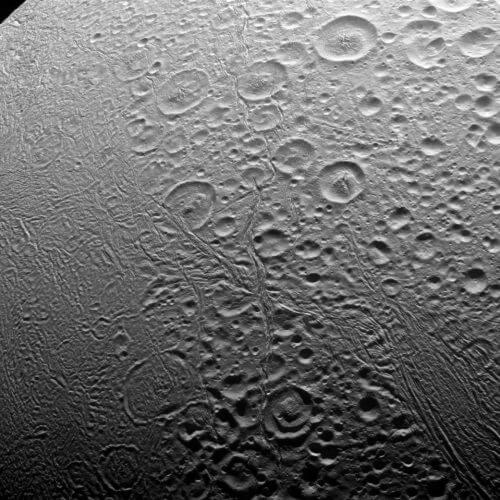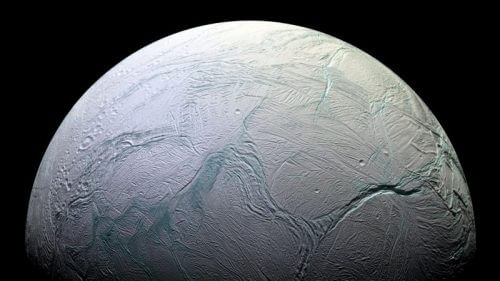Enceladus, a tiny moon of the gas giant Saturn, is best known for the geysers that erupt from its south pole and originate from an internal ocean hidden beneath its outer ice sheet. But Enceladus' north pole is very different from its south pole.

When a planet or moon is tilted on their axis, during their movement around the sun for parts of their year (each planet and moon has its own year) their poles for extended periods will be completely dark or bright. As the angle of inclination is greater, larger parts of the pole will be darker or illuminated by the sun and vice versa - as the angle of inclination is smaller, smaller parts of the poles will be dark or illuminated by the sun. The darkening is in the winter season and the lightening is in the summer season.
It is important to understand that winter and summer in the conventional sense are in planets and moons with atmospheres. Some define atmosphereless moons as having seasons as well, this is because of the prolonged darkening and brightening that in earthly terms last for months and years (because of their great distances from the sun - like the moons of Jupiter and Saturn). Since they do not have atmospheres, there are no winds on them and there is no transfer of heat from the day side to the night side. Therefore there are no climatic phenomena in them. One of these moons is Saturn's moon Enceladus.
Since the Cassini spacecraft arrived at Saturn in 2004, during the filming of this moon it was not possible to photograph its pole for this reason - it was completely dark. Only in October 2015 was the north pole of Enceladus fully exposed to light. In terms of the climatic definition, the North Pole was in its summer season.

On 14.10.2015 the spacecraft passed at a distance of 1839 km from the ground. This means high resolution photos. The resulting image showed that this pole was completely different from the South Pole. It has many craters, does not have the massive grooves found in the South Pole, and no geyser eruptions have been observed.
The craters themselves are small, tens of kilometers at most, and most of them are much less. These craters are shallow, none of them are hundreds of meters deep or more. Their average depth is tens of meters and they lack the mountainous relief in the center of many of the craters of the moon and other bodies in the solar system. This could say something about the internal structure of the moon.
In many of the craters, as a result of the impact of the meteorites that create them, a shock wave is created that penetrates inside and when it returns upwards, it pushes towards the surface massive blocks of rock that form the mountainous relief in the center of the crater. This can occur when the interior of the moon is solid. When the interior of the moon is soaked in water and/or viscous, the progress of the shock wave is slowed and so is its return to the surface of the ground weaker and less powerful. The conduction of the shock wave is much weaker than in solid ground. It may be possible to use the presence and absence of crater reliefs and their height above the crater floor for stratigraphic mapping of the interior of planets and moons, in particular what is related to their crust.

The grooves that were found in the North Pole are completely different from those in the South Pole. They are shorter, shallower (about tens of meters deep) and narrower between a few meters and tens of meters. They are somewhat reminiscent of the canyons found on Dion, another moon of Saturn. Some of these channels appear in clusters, a kind of groups of cracks parallel to each other. Some of them cross craters. Which means they were formed after the formation of the craters. The craters themselves did not undergo any deformations as a result of the formation of these channels. The tectonics that created them was much softer than the one that created the South Pole channels. It may be related to tidal forces exerted by Saturn itself and by the nearby moons Mims and Thetis when they are in resonance with him.
מקור
Cassini Zips Over Enceladus North Pole, Reveals Bizarre Spider-web Cracks, 16.10.2016
See more on the subject on the science website:
- Cassini Huygens crashed on Saturn, took pictures until the last moment
- Cassini discovered that the space between Saturn and its rings is almost completely free of dust particles
- Is there life on one of Saturn's icy moons?
- NASA reveals new discoveries from the oceanic worlds of the moons of Jupiter and Saturn

3 תגובות
Idan Menachem Peace be upon you
Your saying is incredibly true, yes, minds will multiply as great as yours, blessed are you
Hello sparrow
A wise question you asked and the answer is if we predict the formation of a crater we will understand that throughout history there have been a number of successful foci for the phenomena and even if we take into account the formation of cracks in the crater shell we will understand that Ann is under the control of the asteroid's acceleration which causes the formation of longitudinal cracks that continue about 8 percent of the diameter of the overall crater and we will even conclude that these craters are similar in shape to the craters on the moon Saturn
What is the reason why we do not witness a multitude of craters like in the picture of the north pole of Enceladus here on Earth? Does the atmosphere also protect against these damages?